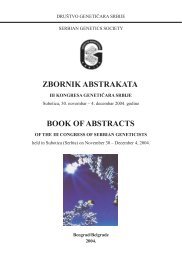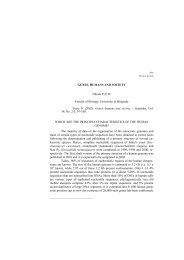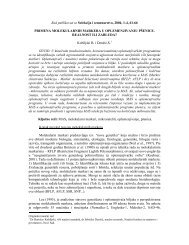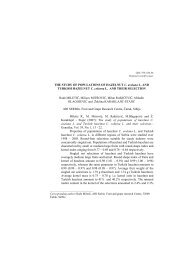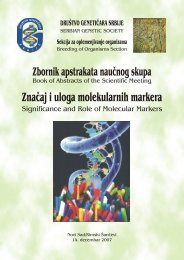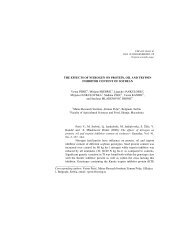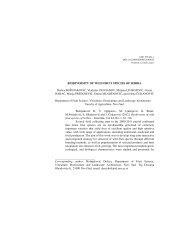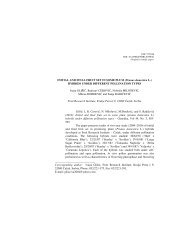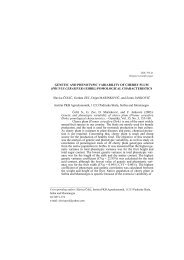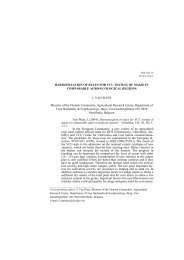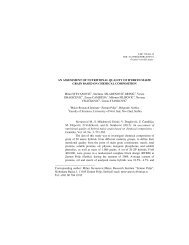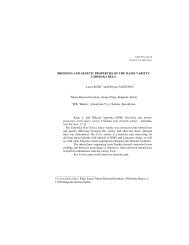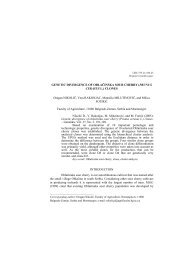Methods of field studies in botany
Methods of field studies in botany
Methods of field studies in botany
Create successful ePaper yourself
Turn your PDF publications into a flip-book with our unique Google optimized e-Paper software.
METHODS OF FIELD STUDIES IN BOTANY<br />
Gordana TOMOVIĆ, Verica MITROVIĆ, and Branka STEVANOVIĆ<br />
575<br />
Review article<br />
Institute <strong>of</strong> Botany and Botanical Garden "Jevremovac", Faculty <strong>of</strong> Biology, 11000<br />
Belgrade, Yugoslavia<br />
Tomović G., V. Mitrović, and B. Stevanović (2001): <strong>Methods</strong> <strong>of</strong><br />
<strong>field</strong> <strong>studies</strong> <strong>in</strong> <strong>botany</strong>. – Genetika, Vol. 34 No. 2-3, 85-95.<br />
Different methods <strong>of</strong> collect<strong>in</strong>g, preparation and preservation <strong>of</strong><br />
plant collections are very important for botanical <strong>field</strong> <strong>studies</strong>. Processed<br />
and labeled plants are stored <strong>in</strong> herbaria <strong>in</strong> which they are conserved and<br />
then used for taxonomic, floristic and phytogeographical <strong>studies</strong>, and then<br />
as the evidence and display material. Besides, various analyses <strong>of</strong> plant<br />
communities and their habitats are used <strong>in</strong> botanical <strong>studies</strong> <strong>of</strong> the flora <strong>of</strong><br />
our surround<strong>in</strong>gs. Field and literature data, as well as, personal communications<br />
and oral presentations are very important sources <strong>of</strong> scientific <strong>in</strong>formation<br />
used <strong>in</strong> flora mapp<strong>in</strong>g <strong>of</strong> a certa<strong>in</strong> region.<br />
Key words: <strong>botany</strong>, <strong>field</strong> study<br />
INTRODUCTION<br />
Botanical <strong>studies</strong> <strong>of</strong> a local region not only are <strong>of</strong> a didactic value, but<br />
they are also the source <strong>of</strong> <strong>in</strong>formation for pupils on diversity <strong>of</strong> nature and a necessity<br />
for protection <strong>of</strong> the region they live <strong>in</strong>. Go<strong>in</strong>g outdoors, visit<strong>in</strong>g nearby<br />
and farther surround<strong>in</strong>gs (on their way from home to school, on playgrounds,<br />
sightsee<strong>in</strong>g sites, etc.), pupils, together with their teachers, can observe the pr<strong>in</strong>cipal<br />
properties, record and collect plants or analyze and describe plant communities<br />
and vegetation <strong>of</strong> the given region.<br />
_______________________________<br />
Correspond<strong>in</strong>g author: Gordana Tomović, Institute <strong>of</strong> Botany and Botanical Garden<br />
"Jevremovac", Faculty <strong>of</strong> Biology, Takovska 43, 11000 Belgrade, Yugoslavia
86 GENETIKA, Vol. 34, No. 2-3, 85-95, 2002.<br />
The collection <strong>of</strong> all plants <strong>of</strong> a particular region or a period comprises the<br />
flora, while overall acqua<strong>in</strong>tance with it is encompassed by various floristic <strong>studies</strong>.<br />
On the other hand, the vegetation is the collective plant cover over <strong>of</strong> a certa<strong>in</strong><br />
region. The <strong>studies</strong> on vegetation are very complicated and encompass <strong>in</strong>vestigations<br />
<strong>of</strong> <strong>in</strong>terrelations <strong>of</strong> numerous plant species that make one plant community or<br />
phytocoenosis (phytocenolic <strong>studies</strong>), as well as, analyses <strong>of</strong> relations, arrangements<br />
and properties <strong>of</strong> all plant communities related to the given region (vegetational<br />
<strong>studies</strong>).<br />
In order to ga<strong>in</strong> proper knowledge on the flora and the vegetation <strong>of</strong> a<br />
certa<strong>in</strong> region it is necessary to carry different both, <strong>field</strong> and laboratory, <strong>studies</strong>.<br />
Field <strong>studies</strong> encompass, first <strong>of</strong> all, list<strong>in</strong>g/register<strong>in</strong>g and collect<strong>in</strong>g <strong>of</strong> the plant<br />
material, as well as, identification and description <strong>of</strong> plant communities that are<br />
made <strong>of</strong> that plant material. The collected material is prepared <strong>in</strong> laboratories for<br />
preservation and a further utilization for stereoscopic and microscopic analyses.<br />
The <strong>field</strong> <strong>in</strong>vestigations can also <strong>in</strong>clude different microclimatic measurements<br />
(solar radiation, solar light, air and soil temperatures, air humidity,<br />
evaporation, etc.) that provide data on a habitat conditions under which liv<strong>in</strong>g<br />
creatures live.<br />
I. COLLECTION, PREPARATION AND PRESERVATION OF FLORISTIC<br />
COLLECTIONS<br />
The follow<strong>in</strong>g parameters are determ<strong>in</strong>ed when floristic <strong>studies</strong> on a certa<strong>in</strong><br />
region are carried out: 1. a presence <strong>of</strong> particular plant species; 2. an affiliation<br />
with certa<strong>in</strong> taxonomic categories; 3. a distribution over a given region; 4. a role<br />
and a place <strong>of</strong> <strong>in</strong>dividual plant species with<strong>in</strong> a certa<strong>in</strong> plant community; 5. morpho-anatomical<br />
plant traits; 6. economical significance; 7. endangerment and z<br />
necessity for protection <strong>of</strong> both, plant species and their habitat.<br />
I.1. Basic pr<strong>in</strong>ciples <strong>of</strong> work<strong>in</strong>g on collect<strong>in</strong>g, prepar<strong>in</strong>g and preserv<strong>in</strong>g <strong>of</strong><br />
collections<br />
1. collect<strong>in</strong>g is done <strong>in</strong> several different habitats; 2. a sufficient number <strong>of</strong><br />
plant species that are observe should be collected (except <strong>in</strong> a case when a species<br />
is scarce or endangered <strong>in</strong> its habitat); 3. representative, mature, <strong>in</strong>tact and undamaged<br />
specimens are collected; 4. the specimens are determ<strong>in</strong>ed (if possible) on<br />
the spot (<strong>of</strong> collect<strong>in</strong>g); 5. collected specimens are fixed (for a wet collection) or<br />
their preservation starts with dry<strong>in</strong>g (for a herbarium collection); 6. basic data on<br />
the collection spot (habitat) are recorded <strong>in</strong> the filed labels attached to the collected<br />
material.<br />
I.2. Field and laboratory tools and material for collect<strong>in</strong>g, prepar<strong>in</strong>g and preserv<strong>in</strong>g<br />
<strong>of</strong> herbarial plants<br />
Field tools and material: - 1. paper for dry<strong>in</strong>g and mount<strong>in</strong>g <strong>of</strong> plants; 2.<br />
cardboard pieces; 3. herbarium covers; 4. herbarium plant press-net; 5. a wooden
G.TOMOVIĆ et al.: METHODS OF FIELD STUDIES IN BOTANY 87<br />
handle iron spade; 6. a spatula, a large and strong knife; 7. a chisel and a hammer<br />
(with one sharp side); 8. an iron hook or an iron anchor to pull out water plants; 9.<br />
a garden pocket knife; 10. a garden saw; 11. garden clippers; 12. a pocket magnifier;<br />
13. tweezers; 14. topographic maps (sections); 15. a compass and an altimeter;<br />
16. a notebook - a <strong>field</strong> log; 17. labels; 18. PVC bags; 19. gallipots and large-diameter<br />
test-tubes with plugs.<br />
Laboratory tools and material: - 1. herbarium paper for stor<strong>in</strong>g plants <strong>in</strong><br />
the herbarium; 2. herbarium labels; 3. herbarium (specimen storage) boxes; 4. envelopes;<br />
5. glass or PVC t<strong>in</strong>n<strong>in</strong>g jars for a wet collection; 6. flasks for chemicals<br />
use for dis<strong>in</strong>fection and des<strong>in</strong>section <strong>of</strong> the herbarium; 7. magnifier (hand and a<br />
table one); 8. a stereoscopic microscope; 9. tools for plant dissection and preparation;<br />
10. herbarium cab<strong>in</strong>ets (compactor units) and shelves; 11. literature for the<br />
plant identification.<br />
I.3. Plann<strong>in</strong>g <strong>of</strong> expeditions and it<strong>in</strong>eraries<br />
The follow<strong>in</strong>g should be foreseen by the expedition plan: 1. the aim and<br />
tasks to be implemented; 2. the duration <strong>of</strong> the expedition, i.e. the departure and<br />
return dates; 3. the direction <strong>of</strong> trekk<strong>in</strong>g, with places <strong>of</strong> rest; 4. the number <strong>of</strong> participants<br />
(per groups); 5. necessary <strong>field</strong> equipment; 6. personal equipment <strong>of</strong> excursion<br />
participants.<br />
Prior to the beg<strong>in</strong>n<strong>in</strong>g <strong>of</strong> detailed <strong>studies</strong> on the flora, habitats and communities<br />
<strong>of</strong> a particular region it is necessary to ga<strong>in</strong> <strong>in</strong>formation <strong>of</strong> general characteristics<br />
<strong>of</strong> the region - relief, geological substratum, soil, vegetation conditions,<br />
adjacency <strong>of</strong> population settlements and diverse anthropological effects, etc. Furthermore,<br />
it is necessary to check available literature data, as well as, geographical<br />
maps related to the given region. All stated data, as well as, all <strong>field</strong> observances<br />
are registered <strong>in</strong>to the <strong>field</strong> log.<br />
I.4. Collection <strong>of</strong> terrestrial, marsh and water plants<br />
The collection <strong>of</strong> terrestrial plants. Herbaceous plants are collected as the<br />
entire <strong>in</strong>dividuals whereby they must not be torn (pulled <strong>in</strong>to pieces), but have to<br />
be carefully dug up, if possible with <strong>in</strong>tact underground parts. Branches with<br />
leaves, flowers and fruits are cut <strong>in</strong> trees and shrubs. In order to perform a precise<br />
identification it is important to collect several specimens <strong>of</strong> plants <strong>in</strong> all developmental<br />
stages (prior and dur<strong>in</strong>g flower<strong>in</strong>g, as well as, dur<strong>in</strong>g fructify<strong>in</strong>g).<br />
The collection <strong>of</strong> marsh and water plants. The large water plants with well<br />
developed underwater parts, such as water lily is, are collected with 1-2 leaves,<br />
flowers, fruits and a portion <strong>of</strong> rhizome with roots. Smaller and more delicate<br />
plants with th<strong>in</strong> leaves are pulled out <strong>of</strong> water <strong>in</strong> a way that plasticized paper (or<br />
foil) is placed under the plant and all its parts are arranged on the paper <strong>in</strong> their<br />
natural position. Then, the plant together with the paper is pulled out <strong>of</strong> water and<br />
placed between the herbarium cover or on the plant press-net.
88 GENETIKA, Vol. 34, No. 2-3, 85-95, 2002.<br />
A <strong>field</strong> label with all necessary data on the habitat has to be attached to<br />
each collected plant, because the plant with no label has no scientific value.<br />
I.5. Procedure <strong>of</strong> plant dry<strong>in</strong>g<br />
The follow<strong>in</strong>g rules are the pr<strong>in</strong>ciple ones <strong>in</strong> the process <strong>of</strong> plant dry<strong>in</strong>g:<br />
1. plants have to be dried fast <strong>in</strong> order to be preserved from deterioration; 2. it is<br />
necessary to use herbarium paper as mach as possible and to replace it with dry<br />
paper as <strong>of</strong>ten as possible; 3. dry plants should be kept away from wet ones; 4.<br />
plants on the plant press-net should be <strong>of</strong>ten surveyed so that their dry<strong>in</strong>g is properly<br />
controlled; 5. labels should not be mixed up when paper sheets are replaced;<br />
6. plants that have been collected dur<strong>in</strong>g conditions <strong>of</strong> dew or ra<strong>in</strong>, should previously<br />
be dried by cotton balls or a piece <strong>of</strong> blott<strong>in</strong>g paper and then placed on the<br />
plant press-net.<br />
I.6. Process<strong>in</strong>g, storage and preservation<br />
A herbarium is a collection <strong>of</strong> selected, documented and dried plants.<br />
The herbarium sheet is a paper sheet <strong>of</strong> a pale color, 63 x 47 cm <strong>in</strong> size, folded by<br />
the width; hence the envelope <strong>of</strong> 47 x 31.5 cm is formed present<strong>in</strong>g a herbarium<br />
half-sheet. There is a firmer paper sheet with<strong>in</strong> the herbarium half-sheet to which a<br />
plant is mounted. A herbarium specimen (exemplar) comprises several<br />
<strong>in</strong>dividual plants, collected <strong>in</strong> a certa<strong>in</strong> location well present<strong>in</strong>g a given plant species.<br />
The herbarium specimen encompasses at least one herbarium sheet; if a plant<br />
is <strong>of</strong> a larger size, the specimen can <strong>in</strong>clude several sheets that will encompass<br />
certa<strong>in</strong> plant parts (above ground and under ground parts). Herbarium specimens<br />
are placed <strong>in</strong>to envelopes and then <strong>in</strong> the herbarium (specimen storage) boxes and<br />
cab<strong>in</strong>ets.<br />
Label<strong>in</strong>g. The dried and processed herbarium specimen is always accompanied<br />
by a herbarium label that differs from a <strong>field</strong> one by a greater number<br />
<strong>of</strong> pieces <strong>of</strong> <strong>in</strong>formation related to a given plant. The size <strong>of</strong> a typical herbarium<br />
label (usually <strong>of</strong> a white photocopier paper) approximately amounts to 15 x 10 cm.<br />
The def<strong>in</strong>ite herbarium label conta<strong>in</strong>s the follow<strong>in</strong>g: 1. Herbarium - the<br />
<strong>of</strong>ficial name, abbreviation or herbarium designation; 2. Scientific plant name<br />
(Lat<strong>in</strong> name and the name given by the author); 3. Location (broader and narrower<br />
determ<strong>in</strong>ation); 4. Habitat, i.e. plant community (oak forest, rocks, flooded<br />
meadow, etc.); 5. Altitude; 6. Medium; 7. The date <strong>of</strong> collect<strong>in</strong>g; 8. The name <strong>of</strong><br />
the collector (labeled with Leg. - to collect <strong>in</strong> Lat<strong>in</strong>); 9. The name <strong>of</strong> the person<br />
who identified the plant (labeled with Det. - to determ<strong>in</strong>e <strong>in</strong> Lat<strong>in</strong>); 10. Number<br />
under which the plant is registered a) collection number - by a collector b) <strong>in</strong>ventory<br />
number - under which is registered <strong>in</strong> the herbarium catalogue.<br />
The herbarium collection is arranged by either the phylogenetic system<br />
(by classify<strong>in</strong>g specimens <strong>in</strong>to taxonomic categories from the evolutionary elder<br />
towards younger groups) or by the alphabetic order. The herbarium can be arranged<br />
accord<strong>in</strong>g to its specific purposes: herbaria <strong>of</strong> medic<strong>in</strong>al, toxic, <strong>in</strong>dustrial,
G.TOMOVIĆ et al.: METHODS OF FIELD STUDIES IN BOTANY 89<br />
horticultural, <strong>in</strong>door, spice plants, etc. At the same time, it is necessary to record all<br />
data presented <strong>in</strong> the herbarium sheet <strong>in</strong> herbarium catalogues (card <strong>in</strong>dex) which<br />
always accompany such collections. Data can be transferred from the catalogues to<br />
the electronic data bases to provide fast and easy f<strong>in</strong>d<strong>in</strong>g, search<strong>in</strong>g and sort<strong>in</strong>g <strong>of</strong><br />
all data relevant for plant species that are stored <strong>in</strong> a certa<strong>in</strong> herbarium.<br />
Storage and preservation <strong>of</strong> herbaria. Herbaria are stored <strong>in</strong> specimen<br />
storage boxes on shelves or <strong>in</strong> cab<strong>in</strong>ets/compactor units. A common label is stuck<br />
on each box with classified material. The ambient conditions <strong>in</strong> the storage rooms -<br />
air temperature <strong>of</strong> almost always 18 o C and relatively low air humidity - should<br />
prevent deterioration <strong>of</strong> the plant material. Preservation <strong>of</strong> the herbarium means<br />
also protection aga<strong>in</strong>st parasites, first <strong>of</strong> all, <strong>in</strong>sects that <strong>in</strong>habit herbaria and fed on<br />
dry plants. Airtight cab<strong>in</strong>ets, isolated premises, as well as, periodical treatments<br />
with certa<strong>in</strong> chemical means (TUS bands or naphthalene) are the best and the least<br />
damag<strong>in</strong>g ways <strong>of</strong> protection aga<strong>in</strong>st pests.<br />
II BASIC PRINCIPLES AND METHODS OF PLANT IDENTIFICATION<br />
The plant identification means recognition <strong>of</strong> a systematic group to which<br />
collected <strong>in</strong>dividuals belong based on their traits that are compared with def<strong>in</strong>ed<br />
diagnoses <strong>in</strong> "keys" for the plant identification.<br />
The fundamental pr<strong>in</strong>ciple for the plant identification is good knowledge<br />
on morphological traits <strong>of</strong> certa<strong>in</strong> plant organs. The entire plant or its certa<strong>in</strong> organs<br />
(especially leaves) can be observed by a magnifier or a stereoscopic microscope<br />
<strong>in</strong> order to make a more adequate identification. Besides, knowledge on<br />
anatomical plant traits that can be observed only on microscopic preparations or<br />
mucilag<strong>in</strong>ous (macerated) plant tissue is sometimes necessary for the detailed<br />
identification <strong>of</strong> the systematic or ecological affiliation <strong>of</strong> plants.<br />
II.1. The application <strong>of</strong> keys and iconography<br />
"Keys" are the books/manuals with <strong>in</strong>troductions for the systematic<br />
identifications <strong>of</strong> plant species. Work<strong>in</strong>g by keys is based on the pr<strong>in</strong>ciple that one<br />
<strong>of</strong> two <strong>of</strong>fered properties (a pr<strong>in</strong>ciple <strong>of</strong> dichotomy) is chosen and opts for and then<br />
forwarded to a subsequent level <strong>of</strong> a dichotomy option<strong>in</strong>g. The pr<strong>in</strong>ciple <strong>of</strong> dichotomy<br />
is applied until the f<strong>in</strong>al goal is achieved, i.e. until the correct Lat<strong>in</strong> name <strong>of</strong><br />
the plant is determ<strong>in</strong>ed. Higher plants <strong>in</strong> Serbia are mostly identified by the Flora<br />
<strong>of</strong> SR Serbia edited by the Serbian Academy <strong>of</strong> Sciences and Art.<br />
Moreover, iconographies, books with draw<strong>in</strong>gs (black and white or<br />
color) <strong>of</strong> plants <strong>of</strong> the certa<strong>in</strong> region, arranged accord<strong>in</strong>g to their systematic affiliation,<br />
can also be used. Higher plants <strong>in</strong> Serbia are mostly identified by the Iconography<br />
<strong>of</strong> Plants <strong>of</strong> Southern, Eastern and Central Regions <strong>of</strong> Europe by Javorka and<br />
Csapody edited by the Hungarian Academy <strong>of</strong> Sciences.
90 GENETIKA, Vol. 34, No. 2-3, 85-95, 2002.<br />
II.2. Mak<strong>in</strong>g plant microscopic preparations<br />
Preparations <strong>of</strong> certa<strong>in</strong> plant organs can be temporary or permanent. The<br />
preparations <strong>of</strong> cross-sections <strong>of</strong> roots, stems/trunks, leaves, fruits or seeds are used<br />
for plant identification.<br />
The temporary preparations made by a razor blade are the simplest way<br />
to obta<strong>in</strong> prompt, general <strong>in</strong>formation on the anatomical properties <strong>of</strong> certa<strong>in</strong> plant<br />
organs. For each new section it is necessary to have a sharp razor blade and additional<br />
tools consist<strong>in</strong>g <strong>of</strong> surgical needle, tweezers, watch glass and dyes - flasks<br />
with fluoroglyc<strong>in</strong>e, muriatic acid or a reagent after Tucakov (BLAŽENČIĆ, 1979).<br />
Manually cut out preparations (if it is dealt with a leaf it is placed <strong>in</strong> the <strong>in</strong>cised<br />
part <strong>of</strong> elder parenchyma) are shortly immersed <strong>in</strong>to dyes and then transferred to a<br />
mount <strong>in</strong> a drop <strong>of</strong> glycer<strong>in</strong>, and then they are protected with a cover<strong>in</strong>g hull and<br />
observed by the microscope. In such a way, s<strong>of</strong>t, cellulose cells rema<strong>in</strong><strong>in</strong>g<br />
uncolored are easily dist<strong>in</strong>guished from woody, lignified and red colored cell<br />
elements (e.g. mechanical and conductive elements). Chloroplasts, i.e. tissues that<br />
conta<strong>in</strong> chloroplast, are easily observed on temporary preparations because they<br />
are <strong>of</strong> an <strong>in</strong>tensive green color.<br />
Permanent preparations are made by conventional methods for light<br />
microscopy <strong>in</strong>clud<strong>in</strong>g: 1. fix<strong>in</strong>g <strong>of</strong> the material <strong>in</strong> the <strong>field</strong> (<strong>in</strong> 50% ethanol solution<br />
with the addition <strong>of</strong> several drops <strong>of</strong> formal<strong>in</strong>); 2. transferr<strong>in</strong>g <strong>in</strong>to adequate fixatives<br />
(accord<strong>in</strong>g to the age <strong>of</strong> the plant material and the preparation purpose); 3.<br />
preparation <strong>of</strong> the material for mold<strong>in</strong>g (<strong>in</strong> paraff<strong>in</strong> or bioplast); 4. cutt<strong>in</strong>g by a<br />
hand microtome; 5. differential dy<strong>in</strong>g <strong>of</strong> the preparation; 6. observance <strong>of</strong> f<strong>in</strong>ished<br />
preparations on microtomes by a video camera with a computer data processor.<br />
III. METHODS OF STUDIES ON PLANT COMMUNITIES<br />
III.1. <strong>Methods</strong> <strong>of</strong> test areas (m<strong>in</strong>imum range <strong>of</strong> distribution)<br />
The identification <strong>of</strong> a plant community type is achieved by the application<br />
<strong>of</strong> the method <strong>of</strong> phytocenolic screen<strong>in</strong>g on so-called "test" areas. The choice<br />
<strong>of</strong> these areas is done on the basis <strong>of</strong> the total survey <strong>of</strong> vegetation <strong>of</strong> a broader<br />
region and selection <strong>of</strong> the areas <strong>in</strong> which the observed vegetation is the most excellently<br />
and the most typically developed. It means that this area is characterized<br />
by relatively consistent ecological conditions; hence the association <strong>of</strong> plant species<br />
characteristic for that vegetation is present there. Simply said, test areas are<br />
usually a central part <strong>of</strong> a certa<strong>in</strong> plant community.<br />
The selected test areas have to be sufficiently large to encompass as a<br />
greater number <strong>of</strong> plants species <strong>of</strong> the analyzed community as possible. The <strong>in</strong>itial<br />
test area <strong>of</strong> only 0.25m 2 is used to register all present plant species. Then the area<br />
is <strong>in</strong>creased to 0.50 m 2 , 1 m 2 , 2 m 2 , 4 m 2 , 8 m 2 , 16 m 2 , 32 m 2 , 64 m 2 etc., as long as<br />
new plant species occur. In such a way, experience on selection a proper test area<br />
for observance <strong>of</strong> a certa<strong>in</strong> plant community is gradually ga<strong>in</strong>ed. The test areas <strong>in</strong><br />
forest communities amount to several hundreds m 2 , while they are always less than
G.TOMOVIĆ et al.: METHODS OF FIELD STUDIES IN BOTANY 91<br />
100 m 2 <strong>in</strong> meadow communities, as forests are <strong>of</strong> a relatively uniform plant composition<br />
on great areas, while the plant content <strong>in</strong> meadow communities is modified<br />
with even m<strong>in</strong>imum variations <strong>of</strong> climatic, geomorphological or pedological<br />
conditions.<br />
Plant communities are characterized by a diverse spatial distribution.<br />
When record<strong>in</strong>g (<strong>in</strong> test areas), plants are grouped accord<strong>in</strong>g to their affiliation to a<br />
certa<strong>in</strong> stratum (large trees stratum, small trees stratum, large shrubs stratum, small<br />
shrubs stratum, large herbaceous plants stratum, small herbaceous plants stratum).<br />
Phytocenolic screen<strong>in</strong>gs, conta<strong>in</strong><strong>in</strong>g the follow<strong>in</strong>g elements, are made on<br />
the basis <strong>of</strong> data on plants and their habitats: 1. the number <strong>of</strong> phytocenolic<br />
screen<strong>in</strong>gs; 2. location (narrower and broader surround<strong>in</strong>gs); 3. very general community<br />
properties; 4. date <strong>of</strong> screen<strong>in</strong>g; 5. size <strong>of</strong> screened area (<strong>in</strong> m 2 ); 6. first and<br />
family name <strong>of</strong> a researcher who performed screen<strong>in</strong>g.<br />
III.2. Data on habitat<br />
1. Altitude (is measured by the altimeter); 2. Exposition (determ<strong>in</strong>ed by a<br />
compass); 3. Slope (expressed <strong>in</strong> degrees and determ<strong>in</strong>ed by an <strong>in</strong>cl<strong>in</strong>ometer); 4.<br />
General geomorphological conditions (characteristics <strong>of</strong> relief); 5. Geological base<br />
(beside rough <strong>field</strong> estimation, a detailed laboratory analysis <strong>of</strong> samples is also<br />
performed); 6. Soil (general data on the type, bed depth, hue and texture, etc.); 7.<br />
General conditions <strong>of</strong> water relationship (presence or absence <strong>of</strong> water areas, under<br />
ground waters, spr<strong>in</strong>gs, etc.); 8. Type and traits <strong>of</strong> adjacent plant communities (that<br />
can affect the habitat and the studied plant community <strong>in</strong> it); 9. Presence and <strong>in</strong>fluences<br />
<strong>of</strong> animals; 10. Anthropological effects (settlements, different anthropological<br />
activities).<br />
III.3. Analytical process<strong>in</strong>g <strong>of</strong> plant communities - phytocenolic screen<strong>in</strong>g<br />
A floristic composition and spatial structure (set <strong>of</strong> successive strata) <strong>of</strong><br />
the plant community, as well as, ecological conditions under which the community<br />
is developed are determ<strong>in</strong>ed by the analytical process<strong>in</strong>g. The distribution and importance<br />
<strong>of</strong> each plant species <strong>in</strong> the formation <strong>of</strong> a plant community is evaluated<br />
on the basis <strong>of</strong> their abundance, coverage and sociability after the method <strong>of</strong><br />
Braun-Blanquet. The follow<strong>in</strong>g parameters are used <strong>in</strong> such an analysis:<br />
The comb<strong>in</strong>ed evaluation <strong>of</strong> abundance and coverage by the 1-6 scale<br />
where 5 - the species covers 75-100% <strong>of</strong> the test area; 4 - the species covers 50-<br />
75% <strong>of</strong> the test area; 3 - the species covers 25-50% <strong>of</strong> the test area; 2 - the species<br />
covers 10-25% <strong>of</strong> the test area; 1 - the species covers 1-10% <strong>of</strong> the test area; + - the<br />
species is scarce with an <strong>in</strong>significant coverage.<br />
The evaluation <strong>of</strong> sociability by the 1-5 scale, where 1 - a plant grows<br />
separately, while the estimates 2 to 5 <strong>in</strong>dicate <strong>in</strong>dividual plant species that form<br />
ever greater associations with<strong>in</strong> a plant community.
92 GENETIKA, Vol. 34, No. 2-3, 85-95, 2002.<br />
III.4. Synthetic process<strong>in</strong>g <strong>of</strong> plant communities - phytocenolic table<br />
Phytocenolic tables are formed on the basis <strong>of</strong> several phytocenolic<br />
screen<strong>in</strong>gs (not less than 10). These tables represent a complex survey <strong>of</strong> the plant<br />
community based on data <strong>of</strong> all phytocenolic screen<strong>in</strong>gs made <strong>in</strong> different locations<br />
<strong>of</strong> the studied region. The def<strong>in</strong>ite status <strong>of</strong> certa<strong>in</strong> plant species <strong>in</strong> the formation<br />
<strong>of</strong> the plant community is obta<strong>in</strong>ed by the comparison <strong>of</strong> the presence (the<br />
degree <strong>of</strong> participation) <strong>of</strong> certa<strong>in</strong> plant species over all phytocenolic screen<strong>in</strong>gs.<br />
The degree <strong>of</strong> presence (participation) is determ<strong>in</strong>ed by the follow<strong>in</strong>g estimates: V<br />
- the species can be found <strong>in</strong> 80-100% <strong>of</strong> screen<strong>in</strong>gs; IV - the species can be found<br />
<strong>in</strong> 60-80% <strong>of</strong> screen<strong>in</strong>gs; III - the species can be found <strong>in</strong> 40-60% <strong>of</strong> screen<strong>in</strong>gs; II<br />
- the species can be found <strong>in</strong> 20-40% <strong>of</strong> screen<strong>in</strong>gs; I - the species can be found <strong>in</strong><br />
1-20% <strong>of</strong> screen<strong>in</strong>gs.<br />
In such a way the follow<strong>in</strong>g can be set aside: 1. reference species; 2. differential<br />
species and 3. accompany<strong>in</strong>g species.<br />
Reference species are always related to a certa<strong>in</strong> community is scientifically<br />
named after them. These species best reflect ecological conditions <strong>of</strong> the<br />
studied habitat.<br />
Differential species occur <strong>in</strong> the observed plant community, but only <strong>in</strong><br />
certa<strong>in</strong> locations and <strong>in</strong>dicate to ecological and floristic specificities <strong>of</strong> such habitats.<br />
Accompany<strong>in</strong>g species are scarcely or randomly found species <strong>in</strong> the<br />
studied plant communities.<br />
IV ECOLOGICAL MAPPING OF THE FLORA<br />
Ecological mapp<strong>in</strong>g <strong>of</strong> the flora represents record<strong>in</strong>g data on the distribution<br />
<strong>of</strong> plant species <strong>of</strong> a certa<strong>in</strong> region <strong>in</strong> the geographical map if possible <strong>in</strong> the<br />
scale <strong>of</strong> 1:25,000; 1:50,000 or 1:100,000 as they provide the most precise determ<strong>in</strong>ation<br />
<strong>of</strong> their locations. The sources <strong>of</strong> data on the plant distribution do not determ<strong>in</strong>ed<br />
the given species only geographically, but also provide <strong>in</strong>formation on<br />
ecological properties <strong>of</strong> its habitat.<br />
The follow<strong>in</strong>g data are sources for the determ<strong>in</strong>ation <strong>of</strong> the certa<strong>in</strong> plant<br />
species distribution and mak<strong>in</strong>g maps <strong>of</strong> ranges <strong>of</strong> their distributions:<br />
1) Field <strong>in</strong>vestigations that encompass systematic visits to the studied region<br />
<strong>in</strong> the precisely determ<strong>in</strong>ed periods (monthly or more <strong>of</strong>ten) dur<strong>in</strong>g the entire<br />
grow<strong>in</strong>g season <strong>in</strong>clud<strong>in</strong>g collection, preparation, identification and label<strong>in</strong>g <strong>of</strong><br />
the plant material.<br />
2) Herbarium collections that can be private ones or can belong to a<br />
certa<strong>in</strong> <strong>in</strong>stitutions, arranged accord<strong>in</strong>g to a phylogenetic system or alphabetical<br />
order. The herbarium specimens are obvious evidence <strong>of</strong> the existence <strong>of</strong> certa<strong>in</strong><br />
plant species <strong>in</strong> a particular region.<br />
3) Literature data published <strong>in</strong> Floras <strong>of</strong> certa<strong>in</strong> regions, floristic and<br />
phytocenolic scientific papers, <strong>field</strong> logs, etc. In some cases, (taxonomically com-
G.TOMOVIĆ et al.: METHODS OF FIELD STUDIES IN BOTANY 93<br />
plex genera and species, ext<strong>in</strong>ct plants, data <strong>of</strong> amateur botanists, etc.), these data<br />
require a <strong>field</strong> audit.<br />
4) Personal communications have to <strong>in</strong>clude the follow<strong>in</strong>g <strong>in</strong>formation:<br />
1. Name <strong>of</strong> plant (scientific/Lat<strong>in</strong> name and the name given by the author); 2. Locations<br />
(broader and narrower determ<strong>in</strong>ation); 3. Habitat; 4. Altitude; 5. Geological<br />
base; 6. Date <strong>of</strong> determ<strong>in</strong>ation; 7. Person who determ<strong>in</strong>ed and identified the plant.<br />
The personal communications on plant distribution are not always reliable s<strong>in</strong>ce<br />
there is no herbarium material for them.<br />
All data used for mapp<strong>in</strong>g (from herbarium labels, published papers or<br />
oral presentations and personal communications) are cited <strong>in</strong> a form <strong>of</strong> a written<br />
comment bellow a map <strong>of</strong> a range <strong>of</strong> distribution. For <strong>in</strong>stance:<br />
Example <strong>of</strong> a herbarium / <strong>field</strong> label:<br />
Cachrys apl<strong>in</strong>a Bieb. Tara, Orno-Ostryetum p<strong>in</strong>etosum nigrae, 850 m,<br />
limestone, (Tomić, Z. June 25, 1968, Herb. No. 2564, BEO!)<br />
Citation <strong>of</strong> a published paper:<br />
Ranunculus acer L., Suva Plan<strong>in</strong>a, bottom, Quercetum fra<strong>in</strong>etto-cerris,<br />
400 m, limestone, (Diklić, N. 1970: 294)<br />
Citation <strong>of</strong> a personal communication:<br />
Anemone nemorosa L., Fruška gora, Čerević, Fagetum montanum, 800<br />
m, silicate, June 14, 1997, Stojšić, V., U.S.!<br />
The follow<strong>in</strong>g methods can be used to record data <strong>in</strong> the map <strong>of</strong> distribution:<br />
1) The dot method where each established f<strong>in</strong>d<strong>in</strong>gs or locations <strong>of</strong> the<br />
given species is marked by a dot (or any other symbol) <strong>in</strong> an appropriate geographical<br />
map. Hence, a system <strong>of</strong> dots <strong>of</strong> different densities will appear on the<br />
map <strong>in</strong> dependence on the map scal<strong>in</strong>g and the number <strong>of</strong> known locations. The<br />
preciseness <strong>of</strong> data record<strong>in</strong>g is obta<strong>in</strong>ed by the use <strong>of</strong> the geographical maps with<br />
a universal transverse mercator grid (UTM MAPS) or by the satellite locat<strong>in</strong>g <strong>of</strong><br />
the f<strong>in</strong>d<strong>in</strong>g by the GPS <strong>in</strong>strument that records longitudes and latitudes <strong>of</strong> certa<strong>in</strong><br />
locations expressed <strong>in</strong> degrees, m<strong>in</strong>utes and seconds.<br />
2) The contour method by which all limits <strong>of</strong> distributions are l<strong>in</strong>ked by<br />
one l<strong>in</strong>e (all adjacent locations) hence an image <strong>of</strong> the shape, ranges and size <strong>of</strong><br />
distributions <strong>of</strong> the given species are obta<strong>in</strong>ed.<br />
3) The comb<strong>in</strong>ed method by which the l<strong>in</strong>e and dots are used simultaneously<br />
to mark locations and to express the shape and size <strong>of</strong> distribution.
94 GENETIKA, Vol. 34, No. 2-3, 85-95, 2002.<br />
CONCLUSION<br />
All stated methods <strong>of</strong> <strong>field</strong> <strong>in</strong>vestigations are the basis for obta<strong>in</strong><strong>in</strong>g <strong>in</strong>formation<br />
on the flora <strong>of</strong> the local environment. If they are used for frequent and<br />
permanent monitor<strong>in</strong>g, the obta<strong>in</strong>ed data on the status and modifications <strong>of</strong> the<br />
vegetation <strong>of</strong> the given region will be ever more precise.<br />
These methods are especially important when they are applied <strong>in</strong> <strong>in</strong>vestigations<br />
<strong>of</strong> endangered plant species, because they provide the evaluation <strong>of</strong> the<br />
level <strong>of</strong> endangerment, as well as, the employment <strong>of</strong> adequate measures <strong>of</strong> protection.<br />
REFERENCES<br />
Received October 1 st , 2002.<br />
Accepted December 16 th , 2002.<br />
BLAŽENČIĆ, J. (1979). Praktikum iz anatomije biljaka sa osnovama mikroskopske tehnike. Naučna<br />
knjiga, Beograd.<br />
JANKOVIĆ, M. (1971). Metodika nastave biologije I. Zavod za izdavanje udžbenika Socijalističke<br />
Republike Srbije, Beograd.<br />
JANKOVIĆ, M. i Đorđević, V. (1981). Primenjena ekologija za IV razred usmerenog obrazovanja<br />
prirodno-tehničke struke, biotehničkog smera. Naučna knjiga,
G.TOMOVIĆ et al.: METHODS OF FIELD STUDIES IN BOTANY 95<br />
METODE TERENSKIH ISTRAŽIVANJA U BOTANICI<br />
Gordana TOMOVIĆ, Verica MITROVIĆ i Branka STEVANOVIĆ<br />
Institut za botaniku i botanička bašta "Jevremovac", Biološki fakultet, Takovska<br />
43, 11000 Beograd,. Jugoslavija<br />
Izvod<br />
Za terenska istraživanja u botanici, veoma su važne različite metode<br />
sakupljanja, preparovanja i održavanja zbirki biljaka. Obrađene i obeležene biljke<br />
deponuju se u herbarijume u kojima se konzerviraju i potom služe za taksonomska,<br />
floristička i fitogeografska istraživanja, a zatim i kao dokazni ili izložbeni materijal.<br />
Pored toga u proučavanju biljnog sveta u našoj okol<strong>in</strong>i, u botanici se koriste i<br />
raznovrsne analize biljnih zajednica i njihovih staništa. Terenski podaci, literatura<br />
kao i usmena saopštenja su važni izvori naučnih <strong>in</strong>formacija za kartiranje flore<br />
nekog područja.<br />
Primljeno 1 X 2002.<br />
Odobreno 16. XII 2002.



